Political advertising has experienced a staggering surge, skyrocketing from $3.9 billion in 2018 to an astonishing $11 billion in 2024. Whether you’re managing your own campaign and seeking guidance or in search of an agency partner to amplify your message, one thing is certain: you need a strong strategy to cut through the competitive noise.
In this guide, we’ll offer a concise yet comprehensive overview of political advertising. We’ll delve into what it is, examine governing laws, and evaluate its benefits and drawbacks.
We’ll also review our approach to political advertising, offering insights on how you can distinguish yourself in the upcoming election cycle.
📑 Table of Contents
Political Advertising Definition: What is Political Campaign Advertising?
Political campaign advertising uses paid media, like TV, radio, and newspapers, to raise awareness, influence opinions, share information, and shape voter attitudes towards parties, policies, or candidates.
Political consultants and campaign staff are often tasked with crafting advertisements that convey messages aimed to resonate with voter demographics and align with societal sentiment.
Who Regulates Political Advertising & Its Laws
Political advertising is regulated to ensure transparency and accuracy in political communications.
According to United States law, political advertising encompasses any direct or indrect appeal for votes, financial support, or opposition in an election campaign using:
- Display ads
- Newspaper ads
- Digital out-of-home billboards
- Lawn signs
- Brochures, flyers, & letters
- Articles & tabloids
- TV presentations
It includes other mass communication methods intended to reach a substantial audience (>100 people), such as periodicals, sample ballots, websites, emails, texts, social media, and other online or electronic mass communication formats.
💡 The United States has a liberal approach to political laws, with minimal content regulation and emphasis on disclosure. The European Union member states and Turkey impose stringent controls to maintain equity and order during political campaigns.
Political advertising does not include letters to the editor, news or feature articles written by an unaffiliated party, or radio or television broadcasts where payment for the space isn’t required.
Sponsor Identification and Other Guidelines
The law requires most political ads to disclose sponsor IDs and report expenditures, benefiting candidates or measures, and presentation timelines to bodies like the Public Disclosure Commission (PDC).
The PDC outlines the following guidelines for Sponsor IDs:
- What to Include in Sponsor ID
- Placement and Size of Sponsor ID
- Exemptions from Sponsor ID
- Sponsor ID in Internal Political Communications
Ad sponsors must also understand guidelines on including candidate details, restrictions on false claims, and rules about borrowing from candidate websites.
- Description of Candidates in Ads
- Handling of False Political Advertising
- Rules for Republishing Online Political Advertising
- Managing Online Campaign Activities
Do political ad media buyers need to worry about the laws and regulations?
“For campaign activation, there’s generally an additional step to initiate things, with most of the compliance handled by the DSP (Demand-Side Platform).
For instance, Xandr had a step in the process before leaving the political ad space, where users input a state, and the corresponding compliance requirements are outlined in the software.
Typically, compliance is automated through the buying platform (DSP), focusing mainly on disclosure and funding sources, requiring minimal knowledge until campaign execution. The process usually centers 80-90% on maintaining spend records and identifying funders, allowing non-experts to navigate it effectively.”
Advantages and Disadvantages of Political Advertising
Political advertising wields a dual-edged sword. On the one hand, it empowers candidates to convey their messages and shape voter opinions.
On the other, it faces criticism for its tendency to disseminate misinformation and potentially create a manipulative electoral environment.
Let’s examine the advantages and disadvantages of political advertising.
Advantages of Political Advertising
1. First- and Third-Party Audience Targeting
First- and Third-Party audience targeting enables campaign creators to tailor messages and reach the right voter demographics. Rich anonymous data sources, including voting records and census information, underpin precise Third-Party (3P) data targeting.
With over a hundred million voting records available, advertisers can craft messages using 3P data that resonate uniquely with varying voter demographics, focusing extensively on those still undecided— the “fence-sitters.”
Example: Single-issue voters who oppose marijuana legalization can be identified and targeted with issue-specific content, showcasing the depth of specificity in targeting options available.
Predictive audiences also play a substantial role. Using prior behaviors and affiliations, predictive models allow advertisers to anticipate the voting preferences of different population segments on various issues to decide who to target with ads.
Example: Advertisers can send specific messages like voter registration reminders to those likely to vote but not registered, thereby moving the needle on campaign outcomes. Messages like, “Hey, in your state, voter registration ends on March 25th! Register Now.”
While First-Party data, obtained directly from candidates’ websites and platforms, is valuable, it can be limited. It usually reaches a population already aligned with the candidate’s viewpoints, thus offering little opportunity to influence undecided or opposing voters.
First- and Third-Party audience targeting enables nuanced strategies, ultimately impacting electoral outcomes by accessing audiences that are typically more receptive due to data-driven precision.
2. Diverse Media Types to Reach Voters
Successful political campaigns use a variety of media strategies to reach diverse voter demographics. Traditional mediums like print, broadcast, and cable TV are reliable channels to connect with older demographics like baby boomers.
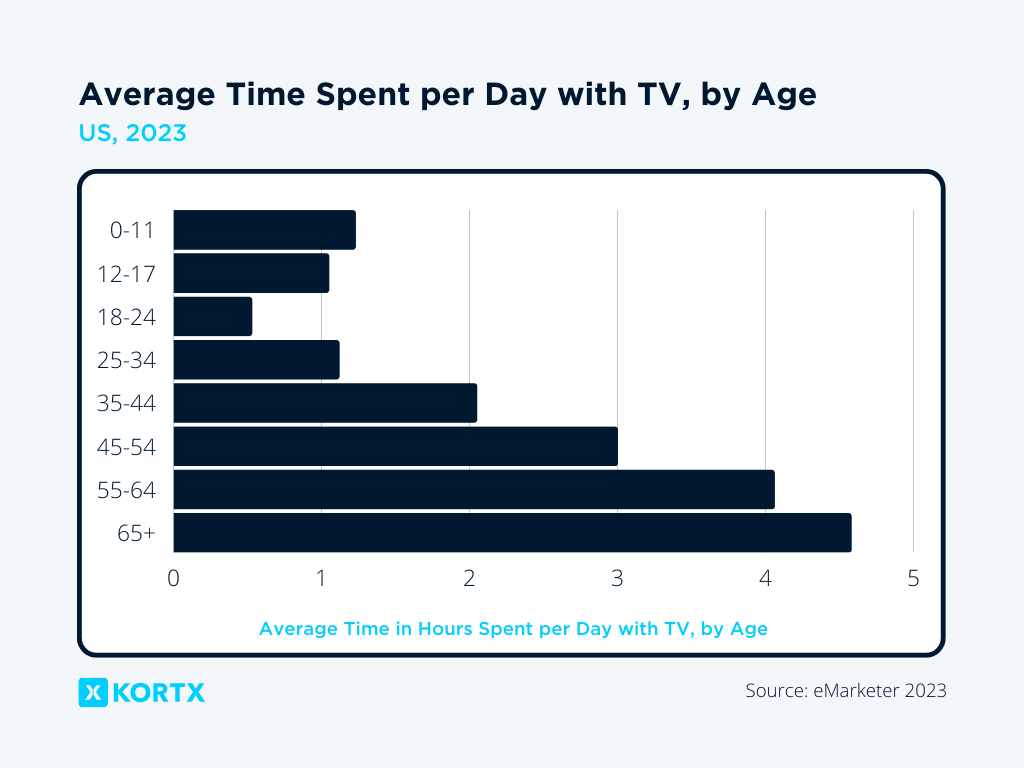
Digital platforms like Display and Online Video (OLV) ads are pivotal in reaching and influencing younger voters.
Example: Placing a TV commercial on Fox News or CNN can capture the attention of older voters, while a well-strategized digital campaign (e.g., smartphones, paid social media) can resonate with younger generations.
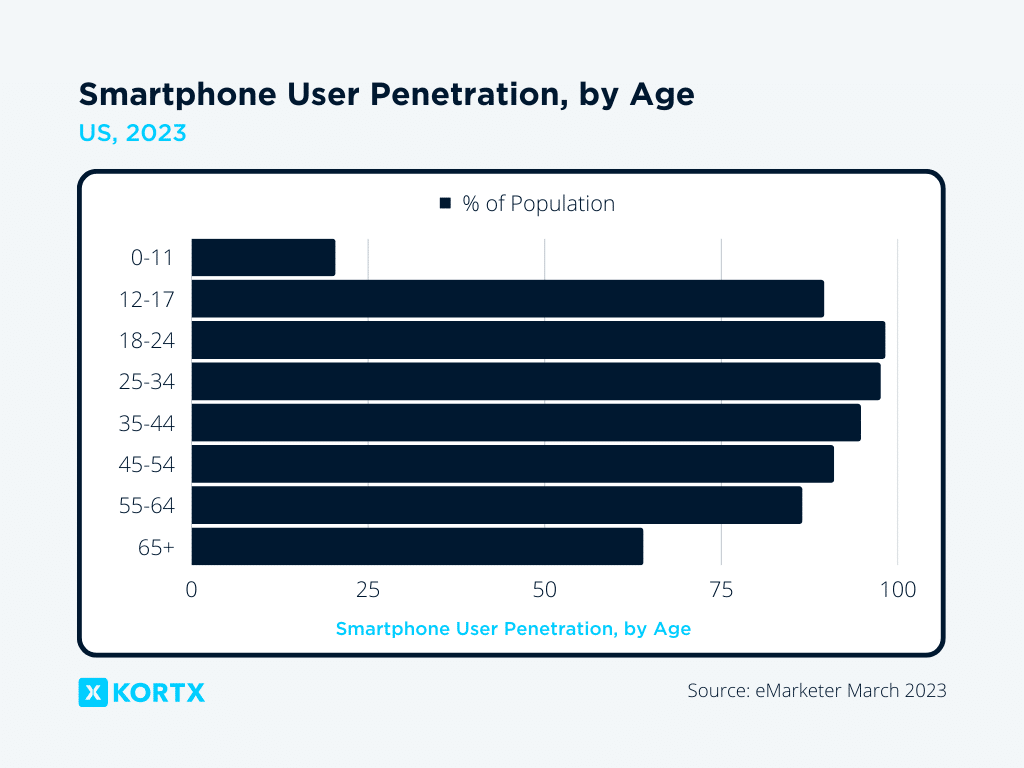
Other media types like Connected TV (CTV) expand across all generations, with two-thirds of the US population watching CTV.
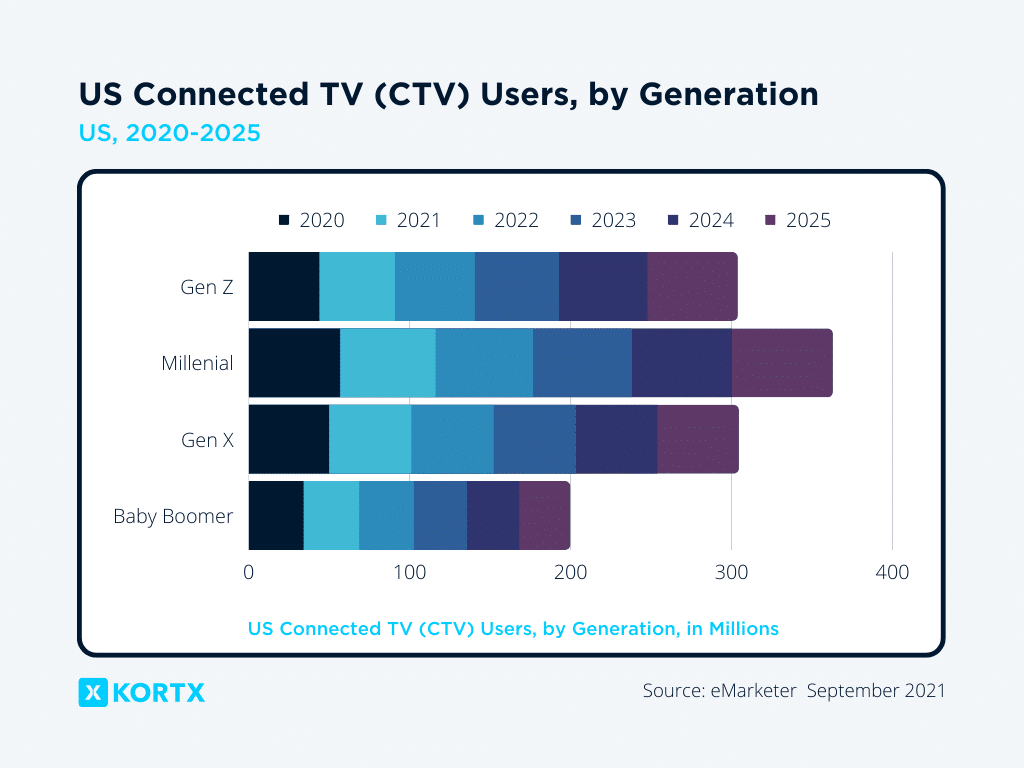
CTV is the fastest-growing advertising channel in 2023. AVOD (ad-supported video-on-demand) and FAST (free ad-supported TV) viewers are expected to grow by 46%, making it a valuable channel to reach voters long-term.
📚 Related Article: Why You Need to Act Fast with FAST Advertising: Read about FAST (free ad-supported streaming TV) advertising, a burgeoning opportunity for advertisers to tap into a diverse and growing audience.
3. Political Seasonality is Top-of-Mind
Media entities meticulously plan around political cycles, aware of the substantial funds that will flood in, setting aside inventory and often prioritizing political advertising over other verticals. This is similar to the expected advertising surge for the Super Bowl every February.
Example: In anticipation of the upcoming presidential election, a major TV network may reserve prime advertising slots for political campaigns, knowing the high demand will allow them to charge premium rates.
This foreknowledge means advertisers can strategically place campaign ads to reach the desired audiences at the best times.
💡 When does political advertising start and stop?
In the United States, political ad timing isn’t strictly defined but generally aligns with the election cycle. Political advertising can start as early as a candidate decides to begin their campaign, which can be years before an election and intensify during the primary and general election seasons.
4. Sports Has Become a Prime Arena for Political Spend
Political ads are now tapping into the popularity of sports programming, a powerful channel to expand their reach and adapt to changing media habits. This shift is occurring against a backdrop where sectors like automakers and insurers significantly reduce their ad budgets.
According to Viamedia, political spending on sports programming rose 170% from 2018 to 2020 and is expected to soar even higher this year, nearly tripling the figures seen during the 2018 midterms.
Ad slots for the Super Bowl were nearly sold out as of September, as is what happened before the last World Cup.
📚 Related Article: Super Bowl Advertising For Under 7 Mill: Discover tips, tricks, and ideas for getting the most out of Super Bowl advertising without the million-dollar price tag.
The Disadvantages of Political Advertising
Now that you understand why political advertising provides unparalleled opportunities, let’s examine some of its drawbacks.
1. Crowded Political Market
In 2022, an estimated $9 billion was spent on midterm election ads, creating an intensely competitive political campaign market. This saturation leads to many ads getting lost in the influx of political messaging and may result in audiences tuning out to ads.
The Good News
Advertisers must enhance their creative strategies to exceed audience expectations and craft memorable messages to address these challenges.
Example: In 1952, Dwight D. Eisenhower, also known as “Ike,” defeated Adlai Stevenson, in part because of a clever little jingle, “You like Ike, I like Ike, everybody likes Ike.”
Example: Bill Clinton’s “Hope” ad helped him win 69% of the electoral vote in 1992. He’s shown as a likable guy next door, rising from his meager beginnings in Hope, Arkansas, bringing hope back to the American dream.
Disclaimer: These examples are provided for illustrative purposes only; we are not associated with any political party.
⭐ Did you know KORTX offers creative political advertising services?
Elevate your campaign with our premium creative advertising services, tailored to make your political message resonate with the right audience.
2. Paying a Premium for Ad Slots
Advertising during political cycles inherently incurs a premium. This is primarily due to the intensified demand in these specific periods, leading to a noticeable increase in both cost and pricing.
Media entities, fully aware of the influx of funds and the unavoidable necessity of campaign spending during these cycles, use this knowledge to their advantage.
Campaigns focused their spending on various formats, including broadcast, CTV, and streaming audio.
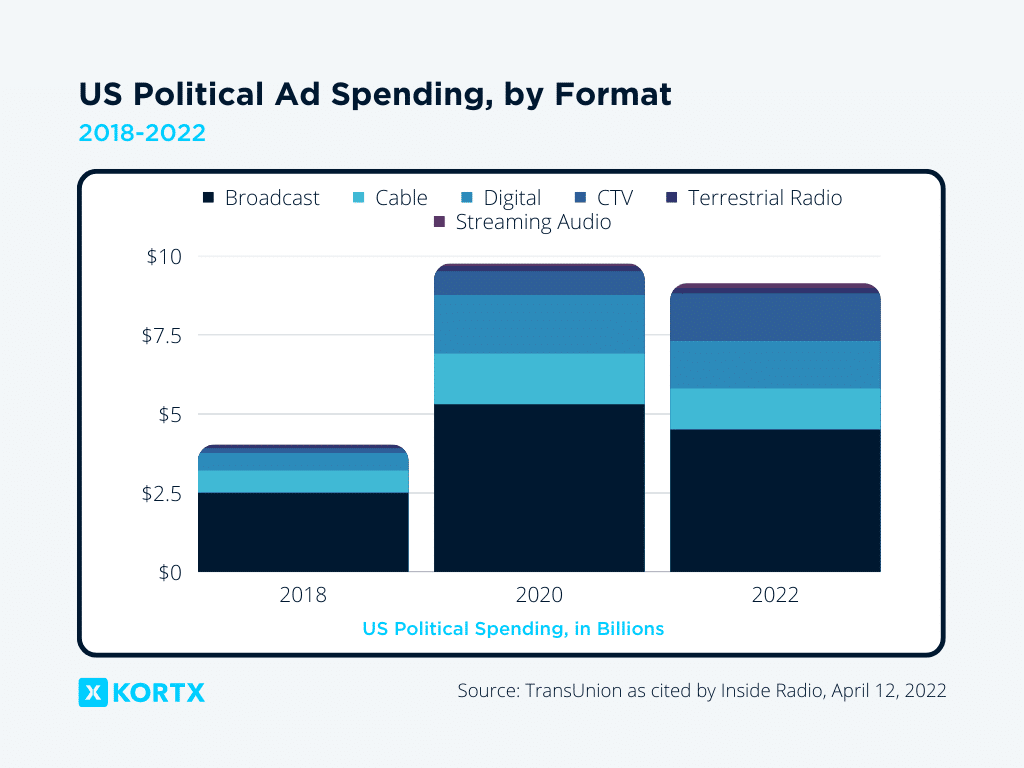
The Good News
According to Tech for Campaigns, $2.3 billion was spent by advertisers on Facebook and Google ads, with an additional $1.5 billion on other digital ads. This represents 10.5% of total advertising and 39% of all expenditures in political digital advertising.
Although political ad spending is expensive, the industry is only getting bigger and bigger at a time when some advertisers are pulling back due to inflationary pressures.
Although political ad spending is expensive, the industry is only getting bigger and bigger at a time when some advertisers are pulling back due to inflationary pressures.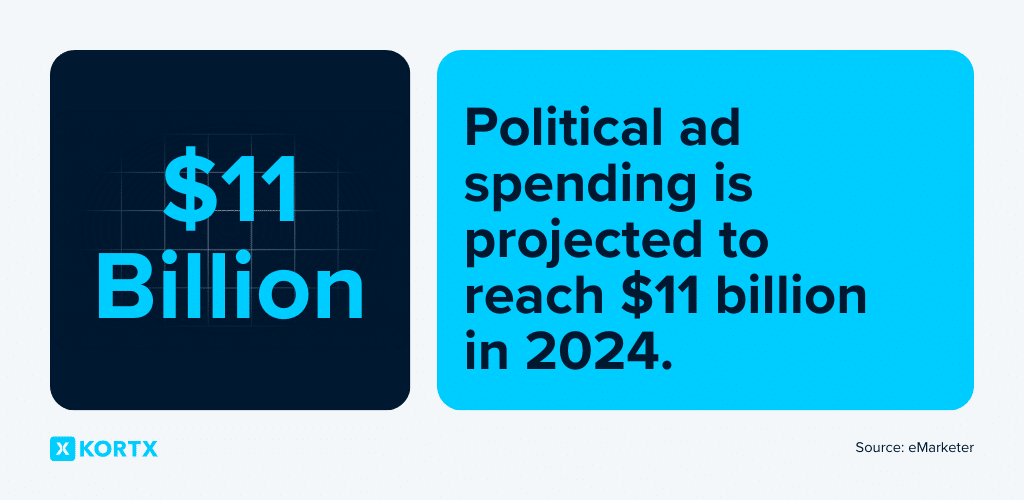
3. Navigating laws and regulations
Political advertising, laden with numerous regulations, can lead to serious repercussions and negative media attention if strategies are not meticulously devised and executed.
And despite higher prices and growing viewership, FAST, AVOD, and streaming platforms maintain stricter standards for political ad acceptance than linear TV. The two new AVOD entrants, Disney+ and Netflix, don’t currently allow political ad spending, although Disney’s Hulu softened a bit.
The Good News
Political ad spending continues to pressure companies to rake in additional ad dollars. Google permitted election denialism on YouTube to capture a share of political spending, suggesting Netflix and Disney+ might eventually follow suit.
How KORTX Helps You Win Your Political Campaign
In political advertising, every decision has the potential to impact the outcome of an election. Luckily, you don’t have to navigate this alone. We understand the stakes and the nuances of connecting with a diverse voter base. That’s why we’ve curated a suite of advanced digital tools tailored to the unique demands of the political landscape.
Moreover, we provide a comprehensive managed service offering, so our team is here to support and handle the technical aspects for you. This allows you to concentrate on crafting your message while we manage the technical details. With our dedicated support, you can focus on the message while we handle the mechanics.
Our Essential Political Advertising Products
Axon Audience Manager for Politics
Axon Audience Manager is an audience analytics tool/our lightweight CDP (Custom Data Platform) that analyzes customer data to offer insights, enhancing personalized experiences, marketing ROI, and boosting customer loyalty for improved business outcomes.

Axon optimizes your campaign outreach by consolidating and arranging First-Party voter data into actionable segments. This way, you can enhance your political campaigns without straining your budget.
Learn how to engage constituents more personally with our exclusive early access program, or ask us more about how it can help your campaign’s needs.
KORTX Intelligence for Campaign Strategy
With KORTX Intelligence, our team of strategists analyzes campaigns, the political environment, voter demographics, and competitive factors to provide data-driven recommendations.
Our political media experts will tailor digital plans that resonate with the unique needs and aspirations of your voter base, ensuring you’re always one step ahead in the electoral race.
Try our FREE KORTX Intelligence Report today.
KORTX Campaign Advantage ft. Split Assist™ in Politics
KORTX Campaign Advantage with Split Assist™ offers an updated approach to political campaign strategy. Moving beyond conventional advertising limitations, it provides a dynamic adaptation to the evolving political environment, ensuring messages are not only delivered but also effectively communicated using optimized methods.
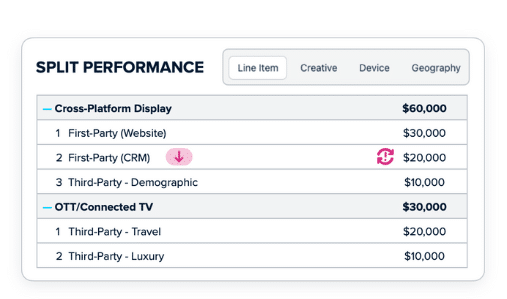
Dynamically allocate and adjust funds rather than being confined to fixed strategy budgets.
Ensure your message is not just heard but effectively communicated using our optimized advertising methods.
📚 Related Article: Programmable Splits and Split Assist (& the Secret Combo to Winning Ad Campaigns): Learn more about how KORTX’s Split Assist™ ensures that campaigns bid on the best-performing audiences and inventory first, leading to improved KPIs and better campaign outcomes.
KORTX Creative Suite for Political Campaigns
Blend art with intent. Our suite marries the essence of your political message with data-backed techniques, such as engaging videos and dynamic ads, keeping voters captivated and motivated.

📚 Related Article: 5 Rich Media Best Practices: Creating Ads That Sell: Learn about the 5 rich media best practices we use in all our creatives to create winning ads.
KORTX Marketing Platform for Political Outreach
Our comprehensive platform sharpens your strategy to align with your political vision, deploys targeted digital campaigns using cutting-edge technology, and provides ongoing insights to outpace competitors.
Make informed campaign decisions with real-time data (all in one user-friendly platform) and ensure every move is efficient and successful.
Our Spotlight Solutions
ID-Free Targeting for Political Campaigns
With the evolving digital environment and the deprecation of Third-Party cookies, political advertisers face challenges in audience addressability, attribution, and campaign functionality.
With KORTX’s advanced cookieless solutions, political advertisers can navigate the new era of political advertising. Using AI-driven, privacy-centric targeting, KORTX ensures genuine connections with voters, making every interaction significant and aligned with evolving privacy standards.
🎯 We helped reduce a client’s display CPA by 70%!
Our ID-free audiences reduced the client’s display CPA by 70%, beating out Third-Party segments and contextual competitors. Read more about our partnership with Dstillery and how it led to this incredible success.
CTV for Political Campaigns
Connected TV (CTV) allows advertisers to reach audiences moving away from traditional TV to digital streaming platforms. Because advertisers can adjust campaigns based on real-time data, it offers flexibility that linear TV doesn’t.
At KORTX, we support your campaign aspirations, whether driving website traffic, fostering grassroots engagement, or amplifying your narrative. In the political realm, we emphasize meaningful impact metrics over superficial numbers.
Picture-in-Picture (PiP) Video, OTT, & CTV for Electoral Engagements
Using our comprehensive and direct inventory, amplify your political messaging on Connected TV (CTV) by connecting with voters during pivotal events, from major political debates to breakthrough announcements.
Or use interactive ad formats like interactive CTV, which drove a 5.42% engagement rate in the last year, compared to a rate of 0.97% for mobile and PC. By integrating our interactive ads into pivotal moments across sports, news, and popular content, you’re positioned for optimal reach and viewer engagement.
Learn more about our interactive CTV offerings in our guide Interactive CTV Ads are the Secret to Higher Engagement and Longer Viewing Rates.

An example of one of our interactive CTV formats, Dynamic Border. Dynamic border PiP ads bring a branded border into the streamed content during critical moments without disrupting the game.
Elevate your political message by connecting with voters during pivotal events, using real-time data and interactive ads tailored to regional tastes and device trends.
KORTX: The Only Political Advertising Agency You’ll Ever Need
So, whether you’re launching your first campaign or are a seasoned politician, trust us to streamline your outreach, amplify your message, and connect genuinely with every voter. With our support, we’ll make sure your campaign is fast, efficient, and wins over your voters.
🚀 We Launch Political Campaigns 2X Faster Than Leading Industry Providers.
We’re not only fast, but our strategies work.
With KORTX, benefit from a quick start campaign, access to premium audiences, precise targeting, customized creative solutions, and a team dedicated to ensuring you win.
Does Political Advertising Work?
Determining the effectiveness of a political advertisement requires a clear and defined method of measuring success. Advertisers can rely on media metrics, including heightened site traffic and increased awareness. This is particularly crucial for new candidates aiming to establish their presence.
How is the effectiveness of political advertising assessed, and what metrics are most valuable?
“The effectiveness of political advertising will vary based on each campaign’s goals. This could be raising a candidate’s name ID, persuading voters one way or the other, or mobilizing people to vote at all. Modern campaigns need to recognize there are modern tools to gauge performance.
While our media options have grown, so have our measurement tools. Campaigns need to use an “all of the above” approach for both media and measurement, as each will only provide a snapshot, whether that’s focus groups, online polling, brand lift studies, or specific calls to action.
The most valuable tools are the ones that best align with the audiences (both demographically and culturally) and how they consume media. A young, diverse electorate likely won’t respond well to phone polling. At the same time, older voters may not be inclined to participate in digital focus groups and in the language of choice for that group.”
Disclaimer: Our quotes are meant to give an unbiased interpretation of political advertising and are not associated with any political party.
Moreover, real-world impacts like voting results and poll movements are important indicators.
Example: If a candidate progresses from a 12% polling in March to 27% in June, it demonstrates that advertising is moving the needle.
Various strategies have traditionally influenced voter perspectives and secured support, including critiquing opponents and forging emotional bonds with the audience.
The Transformative Power and Scope of Political Advertising
Whether positive or negative, political advertising can influence voter perceptions and election outcomes. From a historical perspective, it has served as a decisive element in shaping electoral outcomes, reflecting advancements in media and resonating with the prevailing societal mood.
The scope and influence of political advertising are at an all-time high, making its power a potent antidote to an otherwise slumping advertising landscape.
Our Expert Strategy, Your Success. 🏆
As a distinguished political advertising agency, we specialize in formulating strategies that resonate and influence your audience. Let us be the catalyst for your campaign’s success.
Corey Rice is the Director of Strategy at KORTX and has nearly 18 years of digital marketing experience. Before joining KORTX, he worked at agencies, publishers, and tech companies in San Francisco and Detroit.


